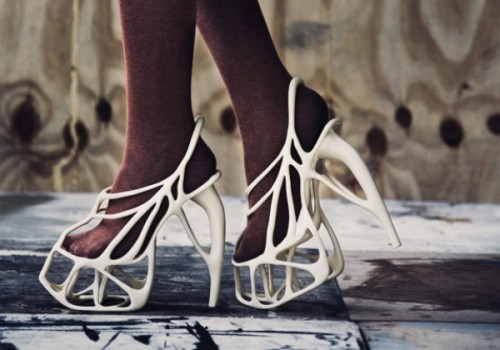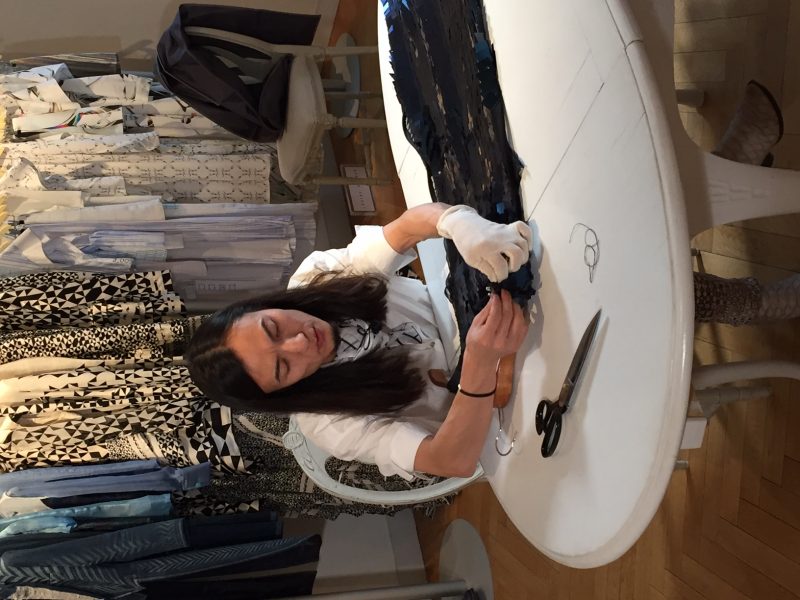Naim Josefi took this year’s Stockholm Fashion Week by storm with his 2017 F/W GANGS collection. The pieces were not only beautiful with shiny sequins and edgy denim pieces, they embodied the perfect collaboration between science and design. That’s what Josefi is known for. The Swedish designer is more like a scientist, always searching for new technology to not only express his creativity but also his beliefs about equality, empowerment and sustainability.
How does he come up with his designs?
“All my collections are built on scientific research. Technology helps me realize complex ideas and thoughts,” said Josefi. For the GANGS collection, his complex ideas were expressed through the use of steel, laser printing and 3D printing technology.
“During the design process, I was inspired by the movie ‘Gangs of New York’. I hope that my design will provide a stronger self-esteem in the tough times we live in and I chose to focus on womenswear with this collection. I always want to contribute to gender equality and with my collection, I intended to highlight women’s incredible strength. Furthermore, I became a dad to a little daughter recently and I wanted to dedicate this collection to her,” said the Swedish designer who is widely known for his win on Project Runway Sweden in 2012.
A Timeless Duo: Steel and Denim
With his background as a bespoke tailor and a keen interest in science, Josefi is spearheading the application of technology into fashion for a highly customized and personal fit. As a result, his pieces incorporate some unlikely materials and the GANGS collection was no exception.
“I think denim and steel are always matched together. You always find steel details in denim garments such as buttons, zippers and rivets. The connection between denim and steel already exists. I just wanted to highlight the collaboration between the Swedish steel industry and fashion industry even more.”
He did just that by using 100 percent recyclable steel sequins to make the dresses for his collection. Josefi worked closely with a steel manufacturer in Munkfors, Sweden. Together, they produced extremely thin bands of steel and added color to them through an electrical heating treatment. Finally, the bands were cut into small sequins via a technique called etching.
What was the hardest part of working with steel?
“The difficulties were in cutting the perfect sizes because the steel I used is very thin- 0.022 mm (1/4 of a human hair) and I needed more than 100,000 pieces. This is my most ambitious high-tech project so far. The dress is made of more than 18,000 pieces of steel sequins in different shades. Every sequin of steel is stitched by hand on a silk fabric.”
[clickToTweet tweet=”This is my most ambitious high-tech project so far. The dress is made of more than 18,000 pieces of steel sequins in different shades.” quote=”This is my most ambitious high-tech project so far. The dress is made of more than 18,000 pieces of steel sequins in different shades.” theme=”style6″]
Designing for Sustainability
Steel sequins were not the only high-tech and sustainable component of his collection. Josefi used denim as his key fabric and incorporated laser printing into the design process.
Why use laser printing?
“To support sustainability. Production is situated in Portugal where we use ecologic denim fabrics with a high-tech laser treatment to create the patterns. The laser technology reduces water consumption by 80 percent in the washing process. The benefits of laser printing for the design is that we get more elegant and clean graphic patterns.”
3D Printing for the Perfect Fit
The GANGS collection was not Josefi’s first attempt at high-tech design. In 2011, Josefi was nominated for a Brit Insurance Design Award for his 3D-printed Melonia shoes.
“I wanted to push forward the concept of tailoring. I came to the idea that the perfect measurement is scanning the body and the perfect tailoring is done by 3D printing the garments. My Melonia shoe was a demonstration of the future tailoring concept.”

Josefi was nominated for a Brit Insurance Design Award for his 3D-printed Melonia shoes. (Source: Arch20)
So, how does one 3D-print a pair of killer heels?
“We scanned the foot and shaped the design digitally in Rhino software to fit the scanned foot and then we printed the design in polyamide in an SLS (Selective Laser Sintering) 3D printer. The technology is still very new and the quality of scanning and 3D printing in different materials is still quite limited.”
For his most recent SS18 collection, Josefi designed 3D-printed steel hats, and is currently working on 3D printing steel jewelry.
“It’s always important for me to push the development further. It’s my responsibility as a designer to challenge the development to something better.”
When asked if he plans on using more steel for future collections, his answer was a definite “Yes.”
| Naim Josefi runs a fashion company based in Stockholm, Sweden. Since his first collection in 2010, Naim Josefi has received several prestigious awards. In 2011, British Design Museum nominated him for the “Designer of the year” award alongside Lanvin, Jil Sander and Comme Des Garçons and his innovative 3D printed shoes were chosen by the Victoria and Albert Museum to be featured in an exhibition showcasing up-and-coming designers that they recommend. One of Naim Josefi’s steel dresses will be on display at the Swedish Embassy in Seoul from November 7 to 17. All of Josefi’s steel projects are in collaboration with the Swedish Steel Association, Jernkontoret. |
Cover photo courtesy of Petroleum Economist.




